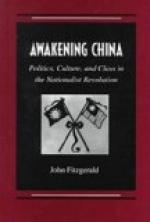After the second reign, that of Hwei-ti, we have the first instance in Chinese history of a woman seizing the reins of government. The Empress Lu made herself supreme, and such were her talents that she held the Empire in absolute subjection for eight years. Like Jezebel she “destroyed all the seed royal,” and filled the various offices with her kindred and favourites. At her death they were butchered without [Page 107] mercy, and a male heir to the throne was proclaimed. His posthumous title Wen-ti, meaning the “learned” or “patron of letters,” marks the progress made by the revival of learning.
One might imagine that these literary emperors would have been satisfied with the recovery of the Confucian classics; but no, a rumour reached them that “there are sages in the West.” The West was India. An embassy was sent, 66 A. D., by Ming-ti to import books and bonzes. The triad of religions was thus completed.
Totally diverse in spirit and essence, the three religions could hardly be expected to harmonise or combine. Confucianism exalts letters, and lays stress on ethics to the neglect of the spiritual world. Taoism inculcates physical discipline; but in practice it has become the mother of degrading superstition—dealing in magic and necromancy. Buddhism saps the foundations of the family and enjoins celibacy as the road to virtue. Metempsychosis is its leading doctrine, and to “think on nothing” its mental discipline. It forbids a flesh diet and deprecates scholarship. Through imperial patronage it acquired a footing in China, but it was long before it felt at home there. As late as the eighth century Han Yu, the greatest writer of the age, ridiculed the relics of Buddha and called on his people to “burn their books, close their temples, and make laity of their monks.”
Yet Buddhism seems to have met a want. It has fostered a sympathy for animal life, and served as a protest against the Sadducean tenets of the lettered class. It long ago became so rooted in the minds of [Page 108] the illiterate, who form nine-tenths of the population, that China may be truly described as the leading Buddhist country of the globe.[*]
[Footnote *: THE APOTHEOSIS OF MERCY
A LEGEND OF KUANYIN PUSA—IN NORTHERN BUDDHISM
Two images adorn this mountain shrine,
Not marble chiselled out by Grecian art,
But carved from wood with Oriental skill.
In days of yore adored by pilgrim throngs,
They languish now without a worshipper.




